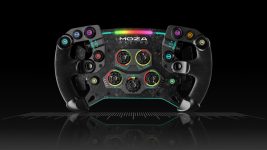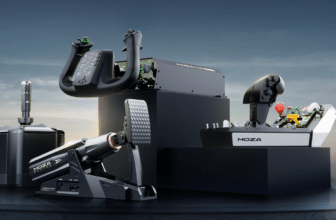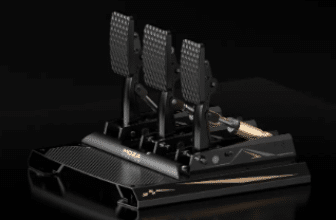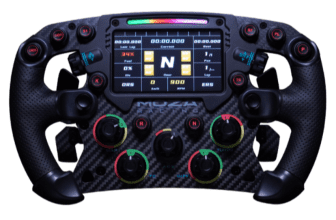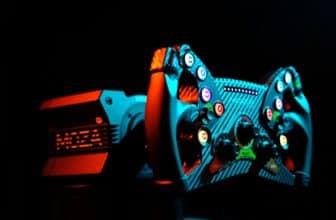Only a few months after the release of its very first models, the Moza Racing brand is expanding its ecosystem. The Moza GS Steering Wheel is their very first Formula-type wheel. And if its release coincides with the Direct Drive Moza Racing R9, it’s no coincidence!
The Chinese brand seems determined to take on the biggest names in the world of simracing. And if the Moza R9 base does indeed have some very good arguments in its favor against the Fanatec CSL DD, it’s time to see if their Moza GS wheel is capable of making a place for itself in your cockpit.
So let’s get straight to the heart of the matter, and see what this Moza Racing wheel has up its sleeve!
The Moza GS wheel from a technical point of view
- Base compatibility: Moza Racing
- Console compatibility: PC
- Vibration: No
- Wheel diameter: 30cm
- Materials: Forged carbon fiber, metal, plastic, alcantara
- Paddles: 2 magnetic shift paddles, 2 clutch paddles
- Customizable buttons: 10 backlit buttons, 5 12-position rotary encoders, 2 clickable thumb switches, 2 clickable joysticks
- Lap counter: 10 LEDs with color adjustment option (7 options)
- Display: No
- Connections: Quick Release Moza Racing D1
Moza GS wheel in brief
Design and ergonomics

I have to admit that when I first received the Moza R9 and the Moza GS wheel, I wasn’t expecting to be transcended. Yes, I know it’s not cool, but I had an apriori. I said to myself, “Come on, it’s just another Chinese company trying to bombard us with offers that are supposed to be great, but in the end don’t really deliver”. And if you’ve read my review of the Direct Drive Moza R9, you’ll know that I was in for a real slap in the face!
Well, it was the same when I opened the box for the Moza GS steering wheel. In concrete terms, it’s just superb. The steering wheel is very handsome, and its dimensions allow it to find its place very naturally in the hands. A real success story!
But a closer look reveals a few finishing details that remind us that Moza is a brand new. A few minor paint and glue defects, some cheap plastics … Nothing too bad in itself, but when you pay almost €500 for a wheel, you’d expect more meticulous work.
The wheel plate is forged carbon fiber. The Italian alcantara grips are very pleasant, but don’t forget the gloves to avoid ruining the alcantara in a few weeks 😉
To discover: 3 models of simracing gloves for less than 40€
On the other hand, I would have really appreciated an effort on the visible plastics on the front. And that the markings under the rotary selectors weren’t just stickers. Well… If they’re stickers, that’s fine, but in that case the installation should be impeccable, which isn’t exactly the case with my model.
4 Palettes at this price, that’s a pleasure!
Big plus: the 10 buttons on the front panel are backlit. Very few steering wheels offer this option. Especially in this price range! As a reminder, this steering wheel is priced at $499, or around €470 depending on the exchange rate.
At the rear are 4 magnetic paddles with photoelectric sensors. Another rarity at this price! At the top of the front panel are the lap counter LEDs, elegantly hidden behind a transparent screen to give the illusion of a bar that gradually lights up as you race.
The box also includes a bag to store the wheel and protect it from dust. 4 adhesive pads to muffle the sound of the paddles. A sheet of stickers to name your buttons and selectors. And finally, an Allen key to access the rear of the paddles and fit the pads.
So, first assessment: it’s beautiful, the finish both superb and frustratingly flawed, and I’m off to my cockpit to install the Moza GS on the R9 base!
Installing the Moza GS Steering Wheel
To install the steering wheel, Moza opted for a Quick Release D1 system. It’s held in place by 10 steel balls that snap into the base’s drive shaft. I won’t beat about the bush: it’s perfect. The flywheel snaps onto the base very easily. I can clearly hear the reassuring sound of the Quick Release locking into place. And once installed, it doesn’t move a muscle.
Gone are the little clicks found on Fanatec’s Quick Release QR1s. Gone are the approximations of Thrustmaster’s plastic Quick Release. We’re clearly on the same level of quality as Simagic, for example.
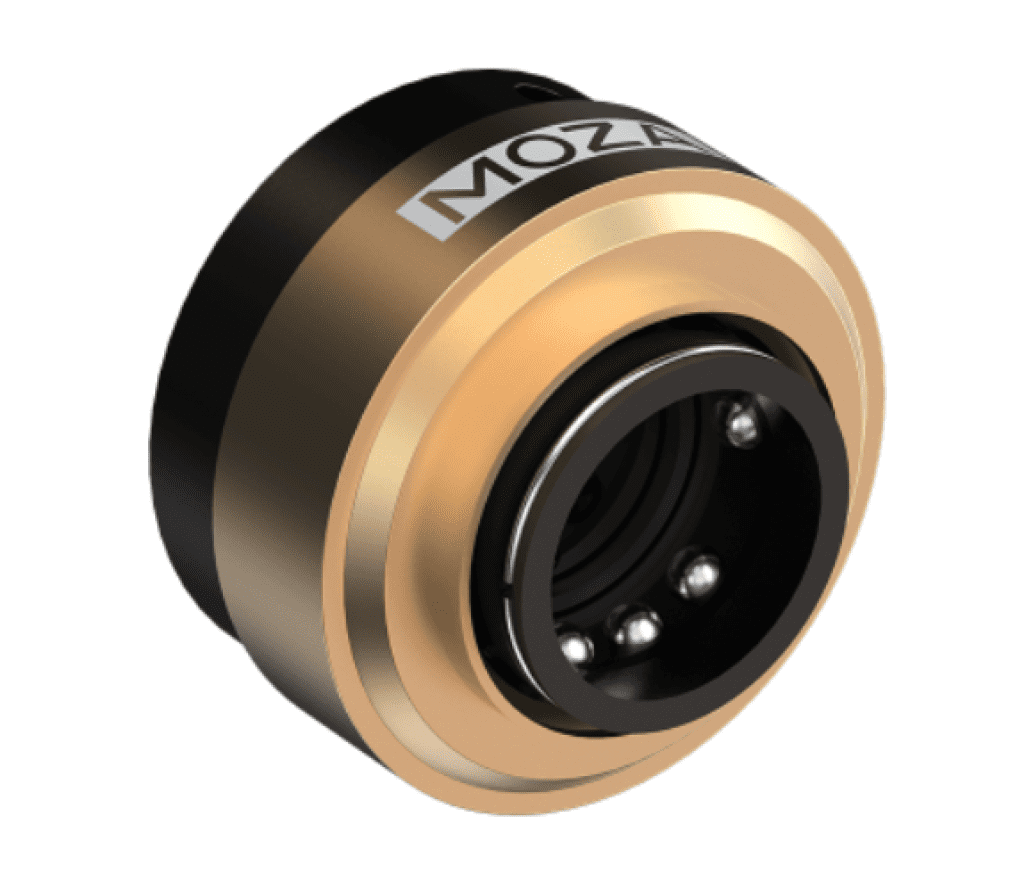
So you’re going to say, “Well, it’s a good thing it’s good stuff, Sam! But remember, we’re talking about a mid-range steering wheel at less than €500, right?
The base and wheel communicate without cables or connections. So we say good-bye to wiring from hell and connection pins that might get bent.
Once again, Moza Racing has thought its product through!
Moza GS Steering Wheel settings and compatibility
For settings, let’s head for the Moza Pit House software. This is where you can adjust the sensitivity of the paddles. You can also change the color of the backlit buttons and the color of the LED bar for the lap counter. There are 7 colors to choose from, but you can also adjust the lighting intensity . Bravo to Moza for this simple, clear and effective software!
For the moment, compatibility is limited to PCs. Not surprising for this type of product, and in any case Moza has no console-compatible base yet.
Comfort and feel
On the track, the steering wheel falls perfectly under your fingers. And even if I strongly advise you to wear gloves so as not to ruin your Alcantara too quickly, you have to admit that the feeling is very pleasant with bare hands.
All buttons are easily accessible without having to let go of the steering wheel. And unlike the Fanatec Clubsport V2.5, whose thumb-level rotary selectors tend to spin as soon as a finger touches them, those on the Moza GS require you to really want to turn them to operate them.
The 30cm diameter is large enough for precise steering on the track.
The only downside concerns the paddles, which make too much (much too much) noise for my taste. But that’s very subjective and can be resolved by using the mute pads included in the box. I also find them a little too far from the grip , and I really have to reach for them with my fingers to engage them. Too bad they’re not adjustable!
The shift paddles are twice as long as on the Fanatec V2.5, for example. As a result, the movement to change gear takes a few hundredths of a second longer, which can probably be a disadvantage when racing.
The same goes for the buttons. They are very pleasant to use, but have a relatively long travel. To give you a concrete example, in F1, when I usually manage to engage the DRS right on the zone line, with this steering wheel I’m always a tenth of a second late.
A helping hand, you might say. Maybe, or maybe it’s simply a youthful error on Moza’s part.
And the divine light illuminated our simracer hearts
On the other hand, I particularly like the backlit buttons. It’s the kind of detail you might find totally superficial, but once you’ve had a taste of it, it’s hard to go back.
The LED bar that gives the illusion of a progressive line of light is also very nice. I don’t recall testing any other steering wheel with this type of lighting. It’s new and well done!
To sum up, the feel of this steering wheel is simply one of quality. Its materials, buttons and Quick Release give you confidence . But the paddles and buttons take some getting used to before you’ll be as quick and efficient as on other models.
Customizing the Moza GS Steering Wheel
If required, you can use the sticker sheet supplied with the Moza GS to customize it and locate the buttons.
It’s also worth noting that the alcantara grips can be removed. Moza doesn’t yet offer a replacement model, but it shouldn’t be long now. Perhaps leather or rubber grips to customize the Moza GS?

